Starting a podcast can be an exhilarating journey, filled with opportunities for personal growth, community building, and the chance to share your unique voice with the world. Whether you’re looking to dive into the realm of storytelling, share expert knowledge, or simply have meaningful conversations, podcasting provides a platform to connect with like-minded individuals and make an impact.
However, embarking on this adventure requires more than just passion; it demands careful planning, dedication, and a willingness to learn and adapt. In this comprehensive guide, we will walk you through how to start a podcast checklist to help you turn your podcasting dreams into reality.
From understanding the time and financial commitments involved to planning your content and finding your unique voice, we’ve got you covered. So, grab a notebook, and let’s start charting your path to podcasting success!
Related: Start a Podcast People Will Listen To
Contents
What You Need To Know Before Starting?
Before you dive headfirst into the world of podcasting, it’s crucial to set realistic expectations and understand what the journey entails. Podcasting is not just about having the right equipment and a great idea; it’s a commitment that will challenge you, inspire you, and, at times, test your patience.
In the following sections, we will delve into the key aspects you need to consider, including the time and financial investments required, as well as the essential skills and knowledge that will set you on the path to success.
Time And Financial Commitments
Podcasting is a labor of love, and like any worthwhile endeavor, it requires a significant investment of time and resources. On average, producing a single podcast episode can take anywhere from 5 to 20 hours, depending on the complexity of the topic, the length of the episode, and your level of experience. This time is spent on research, recording, editing, promoting, and managing various aspects of your podcast.
Financially, the startup costs can range from a few hundred to several thousand dollars, covering equipment, podcast hosting service, software, and potentially hiring professionals for editing or design work. It’s important to create a budget and consider the long-term costs to ensure sustainability.
Investing in quality podcast equipment is crucial, as it directly impacts the sound quality of your podcast. A good microphone, headphones, and audio interface are essential. Additionally, you may need to invest in soundproofing materials to create a quiet recording environment.
Essential Skills And Knowledge

Photo by Sebastian Pandelache on Unsplash
Starting a podcast requires more than just a passion for talking; it demands a diverse set of skills and a willingness to learn. Here are some of the essential skills and knowledge areas you should focus on:
- Audio Editing: Learning how to edit your audio is crucial. There are various software options available, ranging from free to professional-grade. Familiarize yourself with basic editing techniques to enhance sound quality, remove background noise, and create a seamless listening experience.
- Content Creation: Developing engaging and valuable content is at the heart of a successful podcast. Hone your storytelling skills, learn how to structure your episodes, and understand what resonates with your target audience.
- Marketing and Promotion: Building an audience requires strategic marketing and promotion. Learn the ins and outs of social media marketing, email newsletters, and other promotional strategies to increase your podcast’s visibility.
- Technical Know-How: Understand the technical aspects of podcasting, including recording equipment, software, and podcast hosting platforms. Stay updated with the latest industry trends and best practices.
- Networking: Building relationships with other podcasters and industry professionals can open doors to collaborations, sponsorships, and growth opportunities. Attend industry events, join online communities, and network actively.
By investing time in developing these skills and acquiring the necessary knowledge, you are laying a solid foundation for your podcasting journey.
How To Start A Podcast Checklist: Planning
Embarking on the podcasting journey requires meticulous planning and a clear vision. This phase is crucial as it lays the groundwork for your podcast, helping you carve out a unique space in the crowded podcasting landscape. In this section, we will guide you through the essential steps of planning your podcast, ensuring you have a solid plan in place to hit the ground running.
Defining Your Niche And Target Audience
Identifying your niche is the first step in creating a podcast that resonates with listeners. A niche is a specialized segment of the market that appeals to a specific audience. To find your niche, consider your passions, expertise, and the unique perspective you bring to the table. Ask yourself:
- What topics am I passionate about?
- What expertise or unique insights can I share?
- Is there a gap in the market that my podcast can fill?
Once you have identified your niche, it’s time to define your target audience. Who are you speaking to? Understanding your audience is key to creating content that connects and engages. Consider their interests, demographics, and what they are looking for in a podcast. Creating listener personas can be a helpful exercise in this process.
Crafting Your Podcast’s Concept And Format
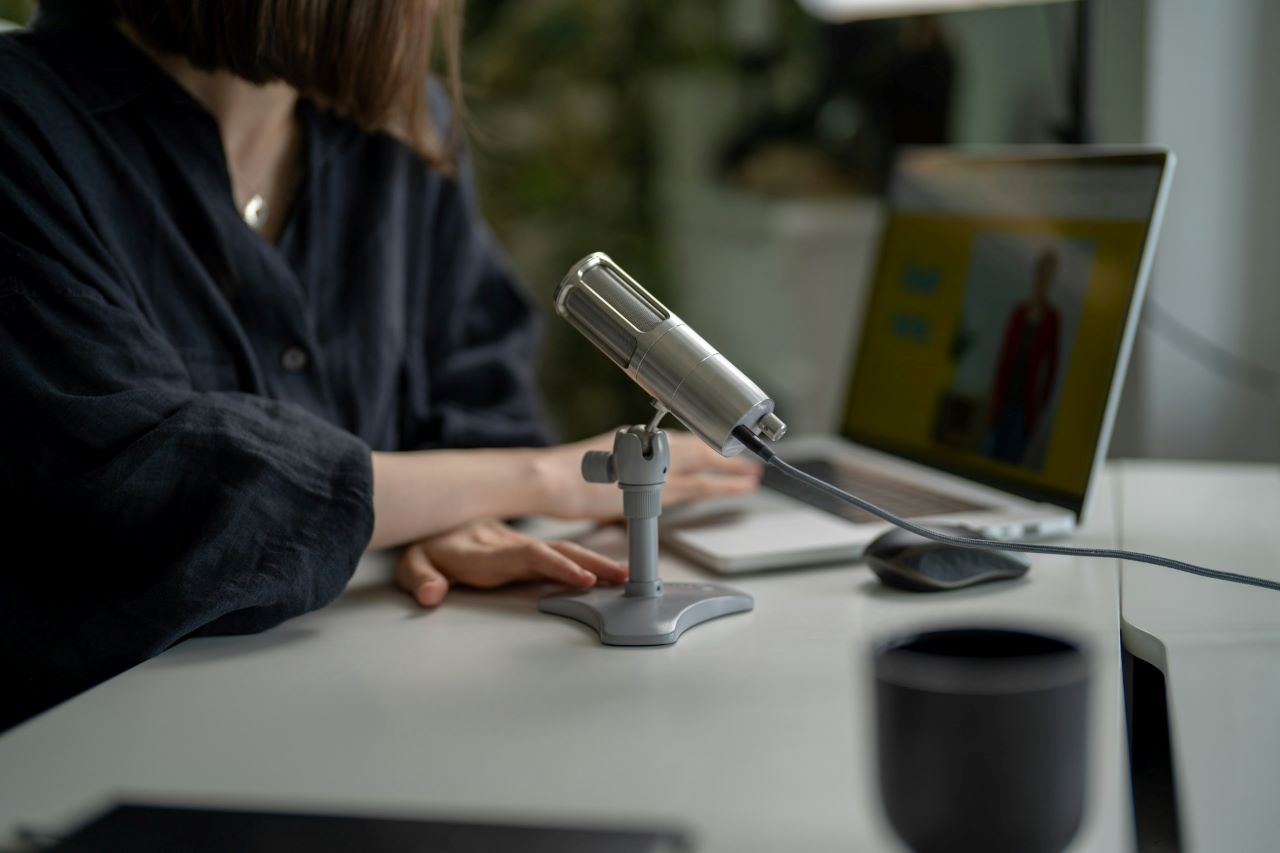
Photo by Sebastian Pandelache on Unsplash
With your niche and target audience in mind, it’s time to craft the concept of your podcast. What is the overarching theme or message you want to convey? How will your podcast stand out from the rest?
Next, decide on the format of your podcast. Will you host solo, co-host, or have guests? Will it be scripted, unscripted, or a mix of both? Consider the tone and style of your podcast as well. Will it be formal, casual, educational, or entertaining? Ensuring consistency in your podcast’s tone and style helps in building a strong brand identity.
Deciding on the Show’s Structure
The structure of your podcast plays a crucial role in keeping listeners engaged. Decide on the segments that will make up each episode, and consider how you will transition between them. Will you have an intro and outro? Will there be ad breaks? Planning this out in advance ensures a smooth and professional listening experience.
Determining the Length and Frequency of Episodes
Consider how long each episode will be and how often you will release new episodes. There is no one-size-fits-all answer here; it depends on your content, format, and audience preferences. However, consistency is key. Choose a release schedule that is manageable and stick to it, as this helps in building a loyal listener base.
Related: Podcast Checklist
Creating A Content Calendar
A content calendar is an invaluable tool in the podcasting process. It helps you plan out episodes in advance, ensuring a consistent release schedule and giving you ample time for research, recording, and editing. Include topics, potential guests, and any other relevant details in your content calendar.
This not only keeps you organized but also helps in maintaining a steady flow of content, preventing last-minute scrambles.
Building A Brand Identity
Your podcast’s brand identity encompasses everything from your logo and cover art to the tone of your content and how you interact with your audience. Creating a strong, consistent brand identity helps make your podcast memorable and build a loyal listener base.
Consider the visual elements of your brand. Your logo and cover art should be eye-catching and reflective of your podcast’s theme and tone. Ensure consistency in the fonts and colors you use, as this helps in building brand recognition.
In terms of content, ensure that your podcast’s tone and style are consistent across episodes. This extends to your interactions with listeners, whether it’s through social media, email newsletters, or any other channels. Consistency builds trust, and trust keeps listeners coming back.
Investing In Quality Equipment
The quality of your podcast’s audio is paramount. Poor sound quality can turn listeners away, regardless of how great your content is. Invest in a good microphone, headphones, and audio interface. Additionally, consider the acoustics of your recording space. Soundproofing materials can help in reducing background noise, ensuring a clear and professional sound quality.
Setting Up Your Recording Space
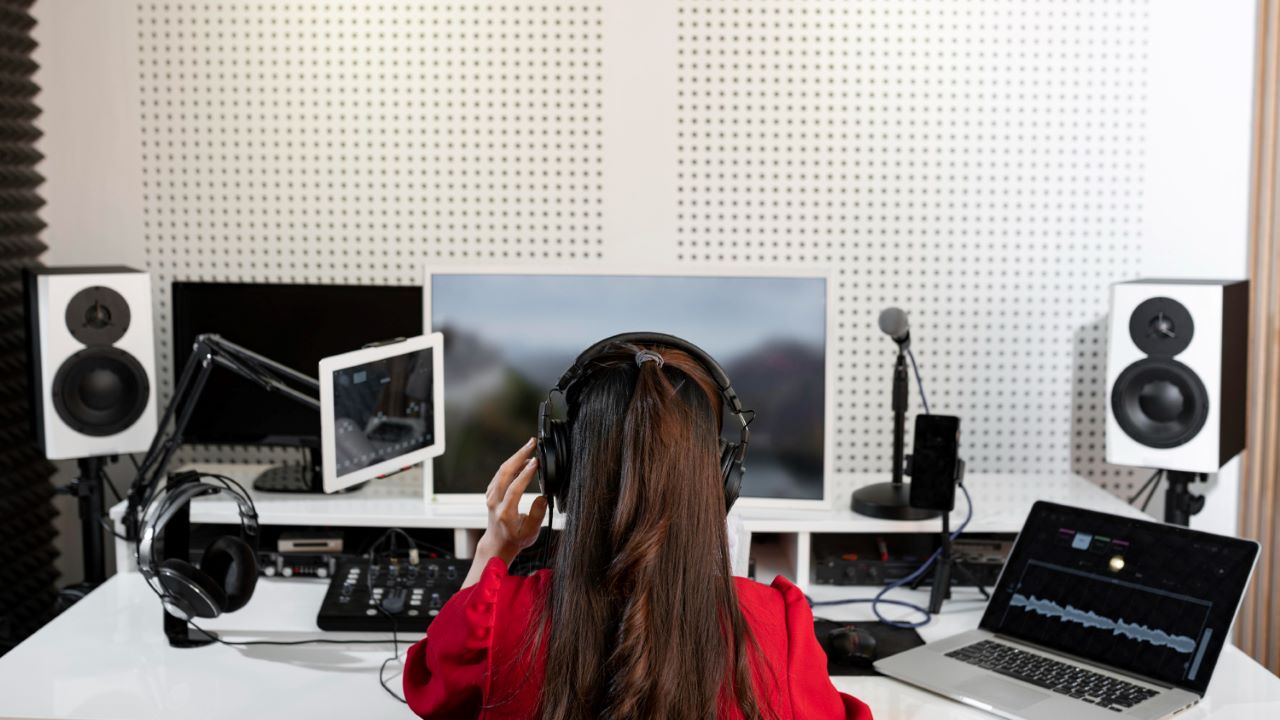
Image by Freepik
Creating a dedicated recording space is a critical step in ensuring the production of high-quality podcast episodes. The environment in which you record can significantly impact the sound quality of your podcast, and taking the time to set up a proper recording space can make all the difference.
In this section, we will guide you through the process of choosing the right location, investing in quality equipment, and selecting the necessary software and tools to bring your podcast to life.
Choosing The Right Location
The location of your recording space plays a pivotal role in achieving optimal sound quality. Look for a quiet, enclosed space with minimal external noise interference. Avoid rooms with hard surfaces as they can cause sound to bounce, resulting in echoes. Instead, opt for spaces with soft furnishings like carpets, curtains, and upholstered furniture, as they help in absorbing sound.
Consider the size of the room as well. Smaller spaces tend to work better for podcast recording as they are easier to soundproof and control acoustically. However, ensure the space is comfortable and allows for free movement, especially if you plan to have guests or co-hosts.
Investing In Quality Equipment
Investing in the right equipment is crucial in achieving professional sound quality for your podcast. This doesn’t necessarily mean spending a fortune, but it does mean choosing equipment that meets your specific needs and ensures clarity and consistency in your audio.
Selecting the Right Microphone
The microphone is arguably the most important piece of equipment in your podcasting setup. There are various types of microphones available, each with their own strengths and use cases. For podcasting, condenser microphones are popular due to their sensitivity and ability to capture a wide range of frequencies. However, they can also pick up background noise, so ensure your recording space is well-soundproofed.
Dynamic microphones are another option known for their durability and ability to isolate sound, making them a good choice for less-than-ideal recording environments.
Essential Accessories and Soundproofing
In addition to your microphone, there are several accessories that can enhance your recording experience. A pop filter helps in reducing plosive sounds, while a shock mount prevents vibrations from reaching the microphone. A boom arm allows for flexible microphone positioning, ensuring you maintain the right distance and angle for optimal sound quality.
Soundproofing is another critical aspect of setting up your recording space. Acoustic panels, diffusers, and bass traps can help in controlling sound reflections and reducing background noise, ensuring a clean, professional sound.
Software And Tools For Recording And Editing
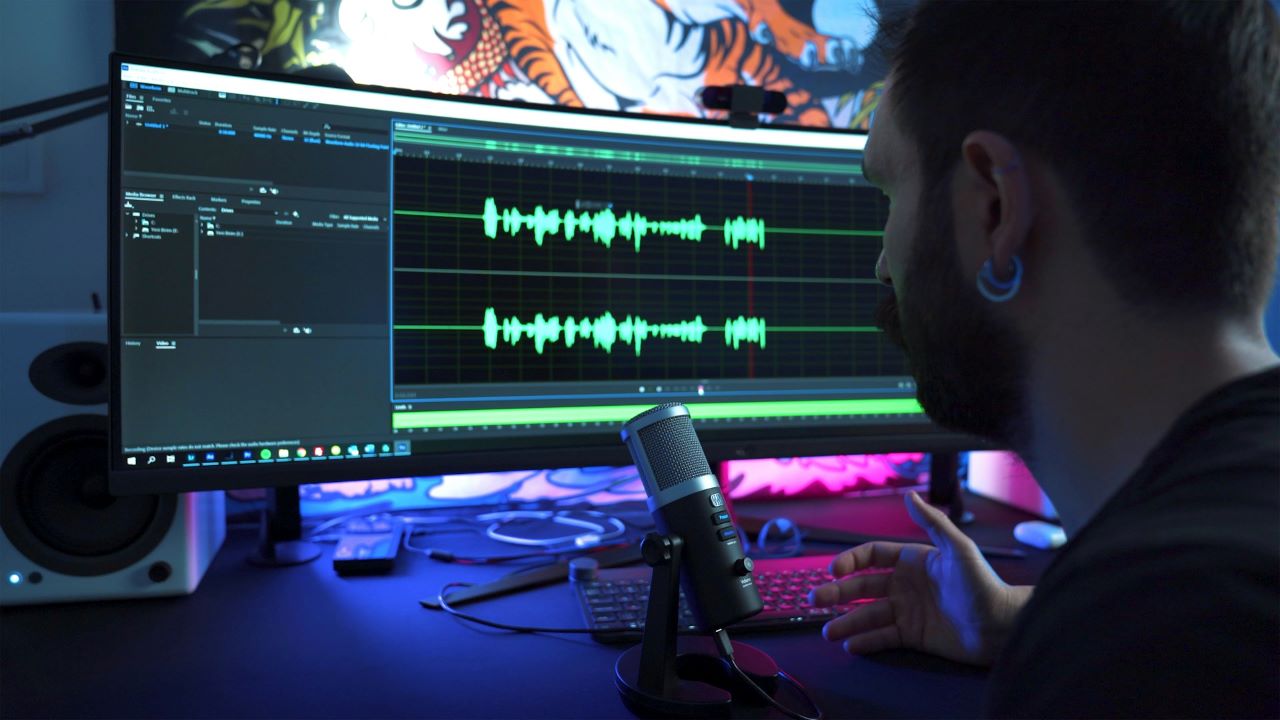
Photo by Onur Binay on Unsplash
Choosing the right software and tools is the final piece of the puzzle in setting up your recording space. There are various recording and editing software options available, ranging from free to professional-grade.
Audacity is a popular free option, offering a range of editing tools and effects to enhance your audio. Adobe Audition and GarageBand are other popular choices, known for their user-friendly interfaces and comprehensive editing capabilities.
Ensure you also have the necessary tools for recording remote interviews if you plan to have guests who are not physically present. Software like Zencastr and SquadCast offer high-quality remote recording options.
Creating A Comfortable And Inspiring Environment
Your recording space should not only be acoustically optimized but also comfortable and inspiring. Ensure you have comfortable seating, good lighting, and any other elements that help in creating a conducive environment for recording.
Personal touches like artwork or inspirational quotes can also help in setting the right mood and boosting creativity.
Establishing A Pre-Recording Routine
Establishing a pre-recording routine can help in ensuring everything is in order before you hit the record button. Check your equipment, ensure your software is up to date, and do a quick sound check to prevent any issues during the recording.
Take a few moments to relax and center yourself, ensuring you are in the right headspace to deliver your best performance.
Keeping Your Recording Space Organized
An organized recording space is a productive recording space. Keep your equipment neatly arranged and ensure all cables are properly stored to prevent damage. Have a system in place for organizing your files, ensuring easy access to past recordings, scripts, and any other materials you may need.
By taking the time to set up a proper recording space and establish routines and organizational systems, you are setting the stage for a smooth and successful podcasting experience.
Recording Your First Episode

Image by Freepik
Recording your first podcast episode is a monumental step in your podcasting journey, marking the transition from planning to execution. This stage requires meticulous preparation, a clear understanding of your content, and the ability to communicate effectively to create a compelling and engaging episode.
In this section, we will guide you through the process of preparing your script or outline, mastering the art of speaking and voice modulation, and editing your audio to perfection.
Preparing Your Script Or Outline
A well-prepared script or outline is crucial for a successful recording session. It ensures that you cover all the necessary points, maintain a logical flow, and stay on topic. Start by defining the main theme of your episode and identifying the key messages you want to convey. Break down the content into sections or segments, making it easier to manage and ensuring a structured flow.
Structuring Your Content for Maximum Impact
Begin with a strong introduction, grabbing your listeners’ attention and setting the tone for the episode. Clearly outline what the episode is about and what listeners can expect to gain from it. Organize the body of your content in a logical manner, ensuring each point builds upon the previous one and contributes to the overall message.
End with a compelling conclusion, summarizing the key takeaways and leaving your listeners with something to ponder or act upon.
Tips for a Smooth Recording Session
- Ensure all equipment is properly set up and functioning before you start.
- Do a sound check to adjust levels and ensure clear audio.
- Keep water nearby to stay hydrated and maintain a clear voice.
- Use your script or outline as a guide, not a verbatim script, to maintain a natural tone.
- Take breaks if needed, especially during longer recording sessions.
- Pay attention to your pacing, ensuring you speak clearly and at a steady rate.
- Be mindful of background noise and eliminate any potential disturbances.
Mastering The Art Of Speaking And Voice Modulation

Image by Freepik
Effective speaking and voice modulation are key to creating an engaging and enjoyable listening experience. Your voice is your main tool in podcasting, and learning how to use it effectively can make a significant difference in the quality of your episodes.
Techniques for Clear and Engaging Speech
- Projection: Ensure your voice is loud enough to be heard clearly but not so loud that it causes distortion.
- Pacing: Maintain a steady pace, ensuring you are not speaking too fast or too slow.
- Tone: Use a conversational tone, as if you are speaking directly to a friend.
- Articulation: Pronounce words clearly and avoid mumbling.
- Emphasis: Use emphasis to highlight key points and add interest to your speech.
- Pauses: Utilize pauses effectively to give listeners time to absorb information and create a natural flow.
Avoiding Common Audio Pitfalls
- Avoid plosive sounds by positioning your microphone correctly and using a pop filter.
- Minimize mouth noises by staying hydrated and taking pauses to swallow.
- Be mindful of background noise and choose a quiet recording environment.
- Avoid excessive use of filler words like “um,” “uh,” and “you know.”
Editing And Polishing Your Audio
Editing is a crucial step in the podcast production process, allowing you to polish your audio, remove any mistakes or unnecessary sections, and enhance the overall sound quality.
Basic Editing Techniques
- Trimming: Remove any unnecessary sections from the beginning, end, or middle of your recording.
- Cutting: Cut out mistakes, long pauses, or any content that doesn’t add value.
- Fading: Use fade in and fade out effects to create smooth transitions.
- Leveling: Ensure consistent audio levels throughout your episode.
- Noise Reduction: Use noise reduction tools to minimize background noise.
Adding Music and Sound Effects
Incorporating music and sound effects can add depth and interest to your podcast, creating a more immersive listening experience. Ensure any music or sound effects used are royalty-free, or you have the proper permissions to use them. Use them sparingly and ensure they complement, rather than distract from, your content.
By following these guidelines and dedicating time to practice and preparation, you will be well on your way to recording a successful first episode and making a strong debut in the world of podcasting.
Launching Your Podcast
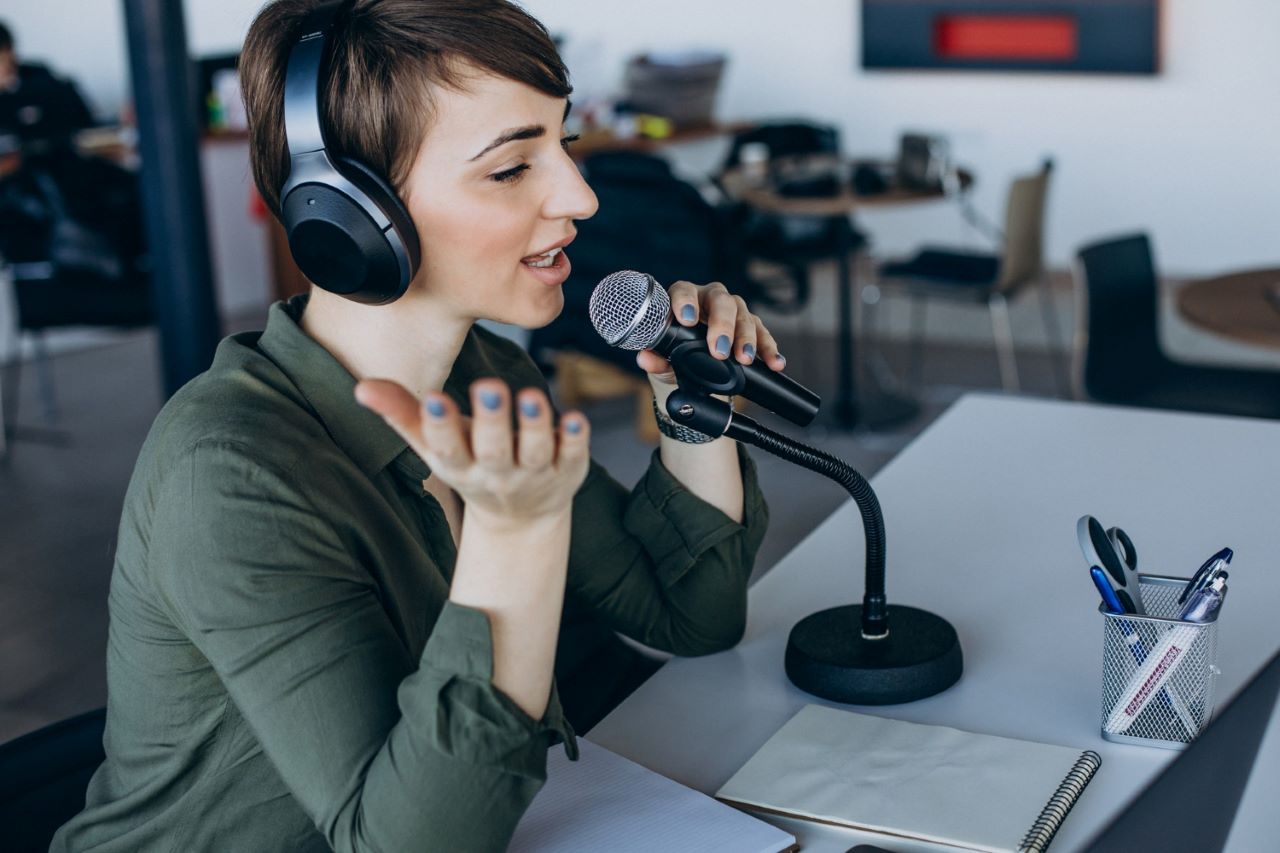
Image by senivpetro on Freepik
Launching your podcast is a thrilling moment, marking the culmination of your hard work and dedication. This phase is critical as it sets the stage for your podcast’s visibility and accessibility to potential listeners. A successful launch requires attention to detail, a strong visual identity, and strategic distribution to ensure your podcast reaches your target audience.
In this section, we will guide you through the process of creating eye-catching artwork and branding, setting up your podcast hosting and RSS feed, and submitting your podcast to directories for maximum reach.
Creating Eye-Catching Artwork And Branding
Your podcast’s artwork and branding play a significant role in attracting and retaining listeners. They create the first impression and contribute to your podcast’s overall identity, making it crucial to invest time and effort in getting them right.
Designing Your Podcast Cover:
- Ensure your design is clear, simple, and easily recognizable, even at a small size.
- Use high-resolution images and legible fonts.
- Choose a color scheme that aligns with your brand identity.
- Adhere to the specifications required by podcast directories for optimal display.
Establishing a Visual Identity:
- Maintain consistency across all branding materials and platforms.
- Ensure uniformity in colors, fonts, and imagery.
- Build brand recognition and trust with your audience through a cohesive visual identity.
Setting Up Your Podcast Hosting And RSS Feed
Choosing the right podcast hosting provider and setting up your RSS feed are crucial steps in ensuring your podcast is accessible and easily distributable.
Choosing the Right Hosting Provider
Select a reliable podcast hosting provider that offers the features and support you need. Consider factors such as storage limits, bandwidth, analytics, and ease of use. Some popular podcast hosting providers include:
- Libsyn: Libsyn, one of the oldest and most trusted hosting providers, offers a range of plans to suit different needs, providing robust analytics and reliable hosting services.
- Podbean: Podbean is another popular choice, known for its user-friendly interface and unlimited hosting plans.
- Anchor: Anchor, owned by Spotify, offers free hosting services and has the added advantage of seamless integration with Spotify, making it a cost-effective option for new podcasters.
Configuring Your RSS Feed for Distribution
Your RSS feed is what allows podcast directories to access and distribute your episodes. Ensure your RSS feed is properly configured with all the necessary information, including your podcast’s title, podcast description, artwork, and episode details. Validate your RSS feed to ensure it meets the specifications required by podcast directories and is free of errors.
Submitting Your Podcast To Directories
Submitting your podcast to directories is a crucial step in increasing its visibility and reach.
Navigating the Submission Process
Each podcast directory has its own submission process and requirements. Familiarize yourself with the submission guidelines of popular directories such as:
- Apple Podcasts: Known for its vast user base and being one of the pioneers in the podcasting industry, Apple Podcasts is a must for any podcaster looking to maximize their reach. To submit your podcast, you need to have an Apple ID and use iTunes Connect. Ensure your podcast meets Apple’s technical specifications, including having a high-resolution cover art and a valid RSS feed. Once submitted, it might take a few days to a week for your podcast to be reviewed and approved. Apple Podcasts provides analytics, allowing you to track the performance of your episodes.
- Spotify: As one of the largest music streaming platforms in the world, Spotify has also made significant strides in the podcasting domain. To submit your podcast to Spotify, you can use the Spotify for Podcasters platform. You need to have a Spotify account, and once logged in, you can add your podcast’s RSS feed for review. The approval process is generally quick, and your podcast could be live on Spotify within a few hours to a couple of days. Spotify also offers analytics, giving insights into your listeners’ demographics and behavior.
- Google Podcasts: Google Podcasts is another key player in the podcasting space, with the added advantage of being integrated into the Android ecosystem and Google Search. To submit your podcast to Google Podcasts, you need to have a Google account and use the Google Podcasts Manager. After adding your podcast’s RSS feed, Google will verify your ownership and review your podcast. The approval process might take a few days. Once approved, your podcast will be accessible on Google Podcasts, and episodes can also appear in Google Search results, increasing your visibility.
Each of these platforms has its own unique features and benefits, and being present on all of them ensures that your podcast is accessible to a wide range of listeners, regardless of their preferred platform. Ensure that you follow each platform’s specific guidelines and requirements to facilitate a smooth submission and approval process.
Promoting Your Podcast on Social Media and Other Platforms
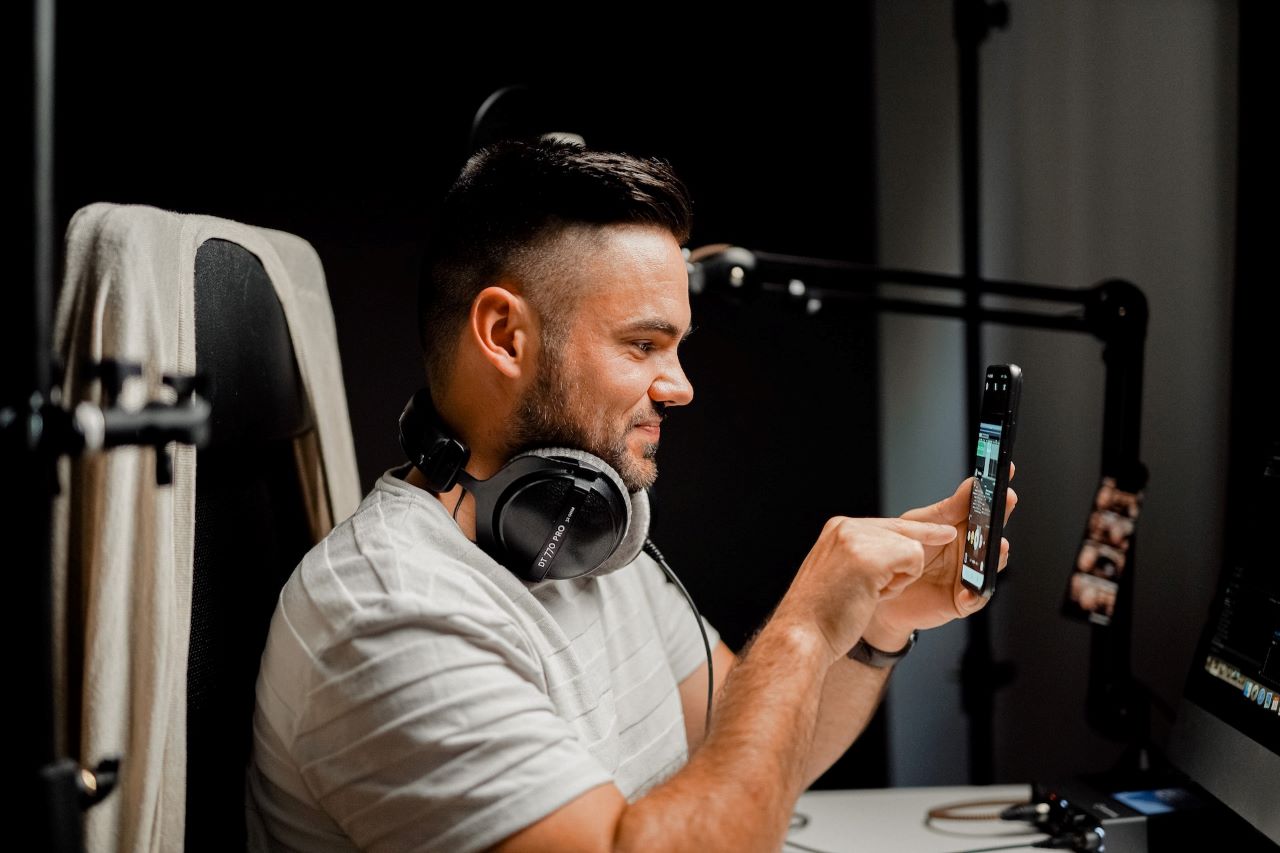
Photo by Malte Helmhold on Unsplash
In addition to submitting your podcast to directories, actively promote it on social media and other platforms to increase its reach. Create engaging content that highlights your episodes, encourages shares, and drives traffic to your podcast. Consider leveraging email newsletters, collaborations with other podcasters, and participation in relevant communities to further boost your podcast’s visibility.
By carefully crafting your podcast’s visual identity, strategically setting up your hosting and distribution, and actively promoting your podcast across various channels, you are setting the stage for a successful launch and building a strong foundation for your podcast’s growth and success.
Growing And Monetizing Your Podcast
Once your podcast is up and running, the next crucial steps involve growing your audience and exploring monetization options. Building a substantial listener base requires strategic planning, consistent content creation, and effective promotion. Monetizing your podcast, on the other hand, can provide you with the financial support needed to sustain and improve your podcasting efforts.
In this section, we will delve into various strategies to help you expand your audience, explore different monetization options, and understand the importance of measuring success and gathering feedback for continuous improvement.
Strategies For Building An Audience
Building a loyal and engaged audience is paramount for the success of your podcast. After launching your podcast and ensuring it is accessible on all major platforms, focus on implementing strategies to attract and retain listeners.
- Content Quality: Prioritize creating high-quality, valuable content that resonates with your target audience. Ensure your audio is clear, your content is well-researched, and your episodes provide unique insights or entertainment.
- Consistent Release Schedule: Maintain a consistent publishing schedule. Regular uploads help retain existing listeners and attract new ones, as they can rely on your podcast for continuous content.
- Engage with Your Audience: Foster a community around your podcast. Engage with your listeners through social media, email newsletters, and live events. Encourage them to share their thoughts and provide feedback.
- Leverage Social Media: Utilize social media platforms to promote your episodes, share behind-the-scenes content, and connect with your audience. Platforms like Instagram, Twitter, and Facebook are powerful tools for reaching potential listeners.
- Collaborate with Other Podcasters: Partner with other podcasters for guest appearances, cross-promotions, or collaborative episodes. This exposes your podcast to a wider audience and helps in building relationships within the podcasting community.
- Optimize for Search: Ensure your podcast is easily discoverable. Use relevant keywords in your episode titles, descriptions, and show notes. This improves your podcast’s visibility on search engines and podcast directories.
Monetization Options For Podcasters

Photo by Videodeck .co on Unsplash
Monetizing your podcast can provide you with the resources needed to cover production costs, improve equipment, and potentially turn your podcasting passion into a profitable venture.
- Sponsorships and Advertisements: Partner with brands and businesses for sponsored content or advertisements. Ensure the products or services you promote are relevant to your audience to maintain trust and authenticity.
- Listener Donations and Crowdfunding: Encourage your listeners to support your podcast through donations or crowdfunding platforms like Patreon. Offer exclusive content, merchandise, or other incentives to donors.
- Merchandise Sales: Create and sell branded merchandise such as t-shirts, mugs, or stickers. This not only provides an additional revenue stream but also helps in promoting your podcast.
- Premium Content and Subscriptions: Offer premium content, early access to episodes, or ad-free listening experiences to subscribers. Platforms like Apple Podcasts and Spotify allow creators to offer subscription-based content.
- Affiliate Marketing: Promote products or services and earn a commission for every sale or lead generated through your affiliate links. Ensure the products or services are relevant to your content and audience.
Measuring Success And Gathering Feedback
Understanding your podcast’s performance and gathering feedback from your audience are crucial for continuous improvement and growth.
- Analyze Listener Metrics: Utilize podcast analytics to track listener demographics, episode downloads, and engagement metrics. Platforms like Apple Podcasts and Spotify provide detailed analytics to help you understand your audience’s behavior.
- Gather Listener Feedback: Encourage your listeners to leave reviews and ratings on podcast directories. Actively seek feedback through surveys, social media, or direct communication.
- Set Clear Goals: Define clear, measurable goals for your podcast. Whether it’s increasing listener numbers, engagement rates, or revenue, having specific targets helps in measuring success and guiding your growth strategies.
- Continuously Improve: Use the insights gathered from analytics and feedback to continuously improve your content, marketing strategies, and monetization efforts. Stay updated with industry trends and be open to experimenting with new formats or strategies.
By implementing these strategies, focusing on audience growth, exploring various monetization options, and continuously measuring success and gathering feedback, you set the stage for a thriving and sustainable podcasting venture.
Conclusion
With the comprehensive guide provided, aspiring podcasters now have a clear roadmap to navigate through the intricacies of starting, launching, and growing a successful podcast. From crafting engaging content and setting up a professional recording space to effectively promoting and monetizing your own podcast, every crucial aspect has been covered to ensure a smooth journey in the podcasting world.
Embrace the process, stay consistent, and watch as your podcast flourishes, connecting you with listeners as a podcast host worldwide and potentially turning your passion into a profitable venture.
